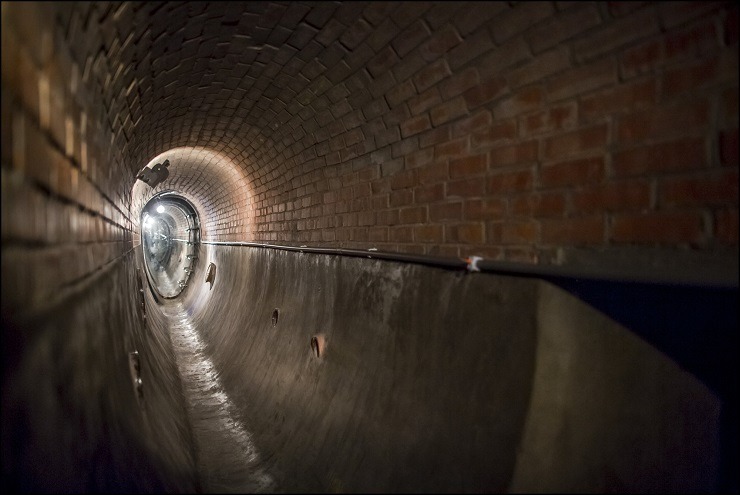Most people walk straight past the two white toll gates at the Porte d’Anderlecht. But push open the door of the south pavilion and you find yourself in one of the city’s most secret museums. The Sewer Museum is one of the only museums in the world that let you go down into a city’s sewer system and learn the hidden history of how the city gets rid of its waste. Opened in 1988, the museum occupies two identical neoclassical pavilions built in the 1830s to collect taxes on goods imported into the city. The tax system was abolished in 1860, but the empty pavilions were left standing.
The visit begins in the south toll house, where you find a fascinating exhibition on the underground pipes that carry Brussels waste. It begins with the extraordinary story of the lost River Senne, which used to meander gently through the old town until it became so polluted that the city authorities put it underground.
The turning point came in 1865 when 3,500 people died from a cholera epidemic linked to the polluted river. Now the Senne runs through a vaulted brick tunnel that forms part of a vast network of drains and pipes built to take waste water out of the city.
The museum used to be owned by the city water authority, but it was taken over by the Brussels department of culture in 2010, adding another museum to the city’s long list of strange collections.
It might sound like a grim place to take your visitors, but the story is told in an interesting way using scale models, city maps and film footage, as well as old photographs of the lost River Senne that look as if they could have been taken in Bruges.
You learn that the city’s sewer system was begun in the 19th century. By 1847, the city had constructed 45 kilometres of vaulted brick tunnels. The network grew to 110 kilometres in 1879 and now runs for 350 kilometres, or further than the distance from Brussels to Paris.
But that’s just Brussels commune in the city centre. When you take all 19 communes, the total length of sewers in Brussels Region amounts to 1,500 kilometres. It’s a massive undertaking that carries waste water for more than a million people, each person on average producing 130 litres a day.
The museum explains the invisible work of the égoutiers, or sewer workers, who spend their days in this hostile urban environment. Their job is made more difficult by illegal chemical discharges, damage caused by construction work, traffic vibrations and tree roots breaking through the brickwork. And then there’s the risk of infection, along with the danger of the tunnels flooding after heavy rainfall.
As if that wasn’t enough, one quarter of the sewer system was recently described by the Brussels water authority Vivaqua as in “poor or very poor state.” The tunnels will have to be renewed over the coming years, but that will cost an estimated €1.5 billion.
With the city already struggling to repair its crumbling road tunnel infrastructure, it hasn’t got a lot of money to deal with the sewage tunnels under the streets. According to a Vivaqua spokesman, the company currently only has funds to renovate 20 kilometres of tunnel every year.
Without regular maintenance, the sewer system is an “underground time bomb,” according to Claude Van Rooten, president of the World Road Association. In 2016, he told De Standaard newspaper that leaking sewer pipes were responsible for the sink holes that had caused chaos in several Brussels locations, including Schuman roundabout. “Mayors prefer to build a new sport stadium rather than repair the sewers,” he observed.
You can see the sewer system for yourself during a short guided tour that takes you down a flight of steps into a gloomy tunnel. The route you follow takes you under the Chaussée de Mons where a metal street sign names the road above your head. It seems the sewer system is like an underground city with its own network of streets, alleys and squares.
You follow a 50-metre stretch of tunnel known as a collector. This is a large tunnel that channels a number of minor tunnels, like a boulevard of raw sewage. You notice a low rumble as water gushes under your feet, along with a vaguely unpleasant smell.
Sometimes you notice a rusty pipe poking through the vaulted roof. “Each one is connected to an individual house,” explained the retired sewer worker leading our group. “Whenever someone takes a shower, or turns on the dishwasher, you can see the waste water pouring out the pipe.”
“And what about rats?” someone asks nervously. “You sometimes see one, but not too often,” the guide says. There are three rats for every Brussels inhabitant, he explains, but they hide away in nests built in the cracks in the walls. “At least it’s not like New York, where there are alligators in the sewers.”
You are more likely to see a condom floating in the water, or a fat deposit, we are told. “You wouldn’t believe what you find,” the guide says. “Bricks, coins, wedding rings. Even guns.”
The museum recently launched an online appeal asking for local residents to send in photographs of toilet graffiti. They will be shown in an exhibition titled Protest in the Toilet to mark the 50th anniversary of the May 1968 revolts in France and Belgium.
The photographs are on display from 26 April to 6 October in an exhibition that includes video footage and sound to recreate the atmosphere of the city’s toilets. “We want to reveal the secrets of these intimate public places,” explained museum curator Aude Hendrick. “We don’t want to censor anything.”
It looks like this hidden museum is about to reveal some of the city’s most intimate secrets.
The Sewer Museum
Porte d’Anderlecht
Central Brussels
+32 (0)2 279 43 83
sewermuseum.brussels
By Derek Blyth

